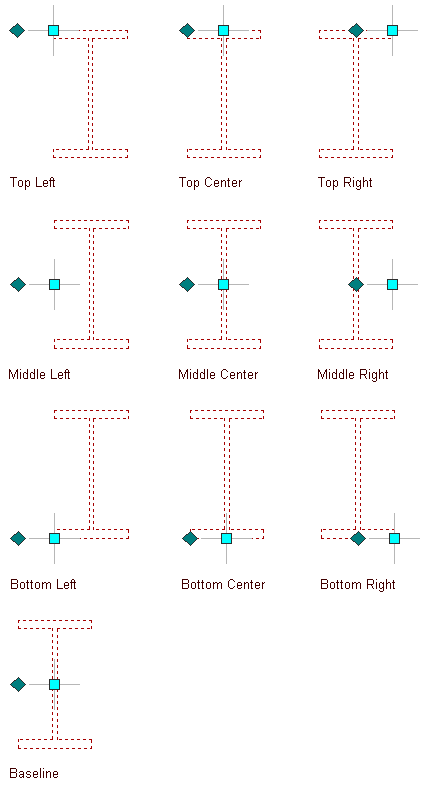Use this procedure to create a structural brace tool and add it to a tool palette.
- Open the tool palette on which you want to add a tool.
- Create the tool:
If you want to… Then… create a tool from a structural member style in the Style Manager click 
 .
.  Locate the style you want to copy, and drag it to the tool palette. Click OK to close the Style Manager.
Locate the style you want to copy, and drag it to the tool palette. Click OK to close the Style Manager. create a tool from a brace in the drawing select the brace, and drag it to the tool palette. copy a tool in the current palette right-click the tool, and click Copy. Right-click, and click Paste. copy a tool from another palette open the other tool palette, right-click the tool, and click Copy. Reopen the palette where you want to add the tool, right-click, and click Paste. copy a tool from the Content Browser open the Content Browser, and locate the tool you want to copy. Position the cursor over the i-drop handle, and drag the tool to the tool palette. - Right-click the new tool, and click Properties.
- Enter a name for the tool.
- Click the setting for Description, enter a description of the tool, and click OK.
The description displays in the tooltip when you select the tool from the tool palette, and describes the tool if you store it in a tool catalog in the Content Browser.
- Expand Basic
 General.
General. - Enter a description of the braces that you can create using this brace tool.
- If you do not want to use the layer assignments specified in the layer key style used in the drawing, specify a layer key and any layer key overrides.
- Select a structural member style, and select a style location, if not the current drawing.
The style provides the shape of the brace.
- Specify a value for Bound spaces:
If you want to… Then… allow the brace to be used as a bounding object for associative spaces select Yes. prevent the brace from being used as a bounding object for associative spaces select No. use the bounding setting from the brace style select By Style. - Specify a value for Trim automatically:
If you want… Then… the geometry of the brace to be automatically trimmed to any other structural members, other architectural objects, or linework to which it is logically connected select Yes. prevent the geometry of the brace from being trimmed automatically select No. use the trim setting from the brace style select By Style. Note: This setting affects only the structural member being added. Adding a new structural member will not change the geometry of an existing structural member, regardless of the setting for Trim automatically. - Expand Dimensions.
- Specify offsets:
If you want to… Then… offset the brace on its extruded axis at the start point of the brace enter a value for Start offset. A positive value shortens the brace on its axis, while a negative value lengthens the brace on its axis. offset the brace on its extruded axis at the endpoint of the brace enter a value for End offset. A positive value lengthens the brace on its axis, while a negative value shortens the brace on its axis. - Enter a value for Roll.
This value specifies the orientation of the brace relative to its extruded axis in terms of degrees of roll. A positive value rolls the brace counterclockwise when viewed from its end to its start.
- Specify the brace justification, which positions the brace shape in relation to its extruded axis when you draw the brace:
If you want to… Then… position the axis of the brace along the centroid of the brace shape select Baseline for Justify. Note: This applies to members created with styles from the Structural Member Catalog only.position the axis of the brace along one of 9 positions on the brace shape select one of the 9 positions for Justify. Note: These positions are defined at a roll of zero, viewing the beam from the end to the start.
Justification options for a brace
- To specify the justification of braces with multiple shapes and segments created with this tool, select a setting for Justify using overall extents:
If you want to… Then… justify the brace based on the largest cross-sectional extent of the member’s lowest priority shapes select Yes. The justification is applied ONLY to the lowest priority shape definitions, and is calculated based on the node (vertex) of the member with the greatest cross section. justify the brace at each node, based on all shapes select No. The justification is calculated based on the cross-sectional extents at each node, and is applied to all the shapes without regard to priority. - Specify the rise, which is the vertical distance between the start point and endpoint of the brace:
If you want to… Then… specify the rise of the brace before you draw it select No for Specify Rise on Screen. For Method, select either Angle, Distance, or Height. If you select Angle, enter a value for Distance along first member (measured from the point where the two members are connected to the point on the first member where you want the brace to start) and a value for Angle from first member. If you select Distance, enter values for both Distance along first member and Distance along second member. If you select Height, enter a value for Rise. specify the rise of the brace by specifying a 3D endpoint for the end of the brace select Yes for Specify Rise on Screen. - Click OK.